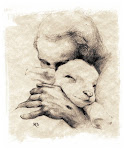
Thursday's Therapy
Emotional Whiplash and "Kindling"
~Robert C. Scaer, M.D.
In 2011, around the time of my birthday in September, Tommy and I went to Atlanta, Georgia to train under Robert C. Scaer, M.D., one of the premier experts in Trauma in regard to how it affects the brain. Here is one of Scaer's articles. To better understand the Trauma of our Child-Loss Grief, you might want to replace the word "whiplash" which we associate with a car accident with the words "emotional whiplash" which best describes our Child-Loss Trauma and PTSD (post-traumatic stress syndrome) as well as our "kindling."
Think of kindling as you would a fire ~ If you keep adding small pieces of wood to a fire, the fire is aroused further, and the fire grows livelier, even becoming resurrected from seeming ashes, at times. So too, our Traumatized emotional state after our child's death, even though seemingly stabilized over time, the Trauma can become aroused further by even small stressful occurrences, and can even become "resurrected" from seeming placidity and calm.
Portions of Robert C. Scaer, M.D.'s article on
"Whiplash and Kindling":
(Peter) Levine presents an intriguing theory of traumatization using the ethologic model of freeze/ immobility resolution in animals in the wild (Levine, 1997):
When a prey animal can no longer escape a predator, it will enter a state of freezeing, or immobility, during which it is unresponsive, atonic and analgesic, but also is undergoing cyclical high levels of sympathetic, parasympathetic and probably endorphinergic activity. If the animal survives, it will arouse, and go through a stereotyped sequence of behaviors manifested by variably intense, repetitive motor activity (trembling, twitching, convulsing) followed by deep respiration and apparent recovery. Levine hypothesizes that humans who freeze or dissociate when confronted with a life-threatening trauma in the face of helplessness, tend not to "discharge" the associated autonomic arousal through neuromuscular activity. Rather, they tend retain it in a state of the sustained potential for cue-related arousal, as in the Vietnam veteran who experiences adrenergic arousal at the sound of a helicopter.
According to Levine, absence of the freeze discharge may facilitate imprinting of the traumatic event in memory linked to arousal, and lead to retention of the "energy" of the fight/flight response in brain circuitry. This state of memory imprinting and sustained arousal-based energy, Levine believes, is the substrate for the development of the symptoms of PTSD, as well as for the development of an additional potential spectrum of psychological and somatic symptoms. He also emphasizes the concepts of resiliency and reserve capacity as limited resources, with each subsequent trauma diminishing the individual’s capacity to tolerate further trauma.
PTSD, MEMORY AND KINDLING
Alterations of memory constitute one of the three subsections of the DSM-IV criteria for the diagnosis of PTSD, including reexperiencing in the form of intrusive recollections, dreams, flashbacks and cue-related arousal. They also participate in the subsection involving avoidance phenomena, including inability to recall important aspects of the trauma, and avoidance of places and events that stimulate recall of the traumatic event. These traumatic epiphenomena involve both declarative (explicit, semantic) and nondeclarative (implicit, procedural) forms of memory. Declarative memory, the form that relates to facts and events and initially involves primarily hippocampal and prefrontal cortical pathways, plays an important role in the conscious recollection of trauma-related events. Procedural memory relates to acquisition of skills and habits, to the development of emotional associations, and to the storing of conditioned sensorimotor responses (van der Kolk, 1994). This form of unconscious memory plays a critical role in the development of many of the linked arousal, sensorimotor and declarative memory symptoms in PTSD. Combining basic concepts of the linking of memory in trauma with retained cue-related arousal leads to a logical hypothesis that attributes the origin of the complex symptoms of whiplash to an actual alteration of brain circuitry. This hypothesis involves the concept of retained neural patterns of activation in the form of kindling, involving centers of arousal (hypothalamus, locus ceruleus, amygdala), declarative memory circuitry (hippocampus), and that portion of brain centers and pathways linked to neuromuscular procedural skill and conditioning memory (basal ganglia, cerebellospinal, vestibulospinal pathways).
The pathophysiological model of kindling was developed in rats by applying a repetitive electrical stimulus to a part of the brain with specific frequency and intensity (Goddard, McIntyre & Leetch, 1969). Application of subthreshold stimuli at a critical frequency could eventually summate and lead to a seizure that ultimately could be self-perpetuating and result in a seizure disorder. The amygdala proved to be the most sensitive area for the development of kindling (Post, Weiss & Smith, 1995). Kindling has been postulated to play a significant role in a variety of psychophysiologic syndromes, including affective disorders, PTSD, chronic pain, post concussion syndrome and multiple chemical sensitivities (Miller, 1997). The phenomenon of kindling has special appeal when considering the genesis of PTSD, a syndrome characterized by variable latency of onset, self-perpetuation, exquisite stimulus sensitivity, the potential to progress and worsen, and in some cases, permanence. These very features characterize many whiplash patients who demonstrate delayed recovery.
The concept that external behavioral stimuli might be the source of theoretically permanent changes in brain physiology and neurochemistry might seem speculative at best. PET scan imaging of regional brain metabolism, including glucose utilization and blood flow, however, shows consistent regional patterns of alteration associated with specific conditions and cognitive activities (Bremner, 1998). These findings lend credence to concepts of brain plasticity required to support such theories as experience-induced neuronal pathway alteration as is felt to occur in the process of kindling.
This hypothesis of a truncated somatically-based discharge of arousal-based activation of strategic brain centers is closely linked to the hypothesis of kindling as the generator for PTSD-related symptoms. In this hypothesis, procedural sensorimotor memory is likely to be established for protective muscular bracing patterns generated by the basic flexor reflexes precipitated by stretch receptor activation at the moment of trauma/impact. Acute arousal would simultaneously be elicited by visual and sensorimotor input signifying threat, accessed by the thalamus and evaluated for emotional content by the amygdala. Declarative memory of this sensory input would establish an explicit memory base for the traumatic event. Lack of dissipation of arousal-based neuronal input associated with the truncated freeze discharge would establish a stimulus generator for continued message transfer through involved linked neuronal circuitry. The amygdala would be exposed to repetitive neuronal input based on persistent cuerelated arousal stimuli as part of this circuit, rapidly setting up a kindled response between centers of arousal, declarative memory and neuromuscular centers for procedural memory. Soon sensorimotor or memory input into any limb of this circuit would activate that center and lead to potentiation of kindling, and progression of the symptom complex. As a result, any incidental declarative memory of the trauma would elicit arousal and patterned regional muscular bracing. Excessive movement of the regional muscle group involved in the original trauma-associated reflex bracing response would elicit arousal linked to procedural memory for that movement pattern, possible conscious memory of the trauma, and further enhancement of reflex muscular bracing. Eventually any nonspecific source of arousal might elicit the same stereotyped regional muscular bracing, as well as on occasion explicit memory for the trauma. Sleep patterns associated with dreams or nightmares of the trauma would cause cyclical nocturnal muscular bracing, bruxing or autonomic manifestations of arousal, including tachycardia and nocturnal diaphoresis. With time, stimuli specific to the trauma might generalize, leading to a broader range of kindled circuitry, and apparent worsening and spread of trauma-related symptoms in the face of nonspecific ambient life stress.
CONCLUSIONS
We have developed a hypothesis of the whiplash syndrome as an essentially brain-based reflex phenomenon, involving linked and kindled circuitry between centers of arousal, declarative and procedural memory, and subcortical motor centers of the basal ganglia and brainstem. Implicit in this theory is the concept of fueling of the development of this circuit by a truncated autonomic and somatically-based freeze/immobility response discharge at the time of the traumatic event, in this case an MVA (Levine, 1997). Once activated, this circuitry is self-perpetuating and relatively permanent as a result of kindling. Although it may be generalized and relatively suppressed by the passage of time and nonspecific therapy, it remains a substrate for increased susceptibility to emotional and somatic symptoms of trauma elicited by increasingly trivial life stresses. Thus a nonspecific life stress in such an individual may precipitate a recurrence of cognitive, emotional and myofascial symptoms from which they had supposedly recovered. Acceptance of the thesis that a relatively trivial stress or emotional trauma may trigger a marked dysfunctional somatic response requires suspension of the concept of Cartesian mind/body dualism, and embracing the burgeoning scientific data supporting th neurophysiologic basis for emotional symptoms and mental illness, as well as their associated somatic conditions. This hypothesis has its base in existing theories of PTSD, and is closely linked to these concepts. The PTSD literature, however, still does not adequately address the somatic elements of traumatization, which I believe to be critical to understanding the entire spectrum of whiplash symptoms, and for that matter, all late symptoms of post-traumatic somatization. This concept of whiplash resolves the dilemmas of delay of onset, persistence and occasional permanence of symptoms, the discrepancy in force exposure and apparent injury, and the occasionally pervasive cognitive and emotional complaints seen in some patients involved in low velocity accidents. It also emphasizes the role of 2/1 response to MVA-induced trauma, and the development of delayed whiplash recovery. This concept of reduced reserve capacity for stress tolerance, and therefore reduced resiliency and increased vulnerability to sequential episodes of traumatic stress, is a basic feature of patients with a history of trauma. Treatment implications for whiplash are clear. Early therapy for exposure to traumatic stress is essential, and should include both counseling, education and preferably addition of somatically based trauma therapy designed to desensitize the autonomic nervous system (Levine, 1997, Wilson, Becker & Tinker, 1995).
Some of the most effective medications for the arousal symptoms of PTSD fall into the category of anticonvulsants, including carbamazepine, valproic acid, gabapentin and clonazepine. These medications might predictably be expected to inhibit the process of kindling. Physical measures for pain treatment can be expected to provide only short-term relief, but inclusion of relaxation techniques and stretching exercises that emphasize inhibition of the stretch reflex should be useful. Acceptance of a unified and logical physiologic basis for the seemingly disparate and disconnected symptoms of whiplash is important to the effective management of the care of these patients. Use of the terms "psychosomatic", "psychophysiologic" and "supratentorial" in a perjorative fashion should be avoided. Many whiplash patients feel dismissed and invalidated by their physicians and auto insurance company representatives. Understanding and validation by the physician, therapist, insurance payor and legal system is less likely to retraumatize the patient and perpetuate the syndrome.












































No comments:
Post a Comment